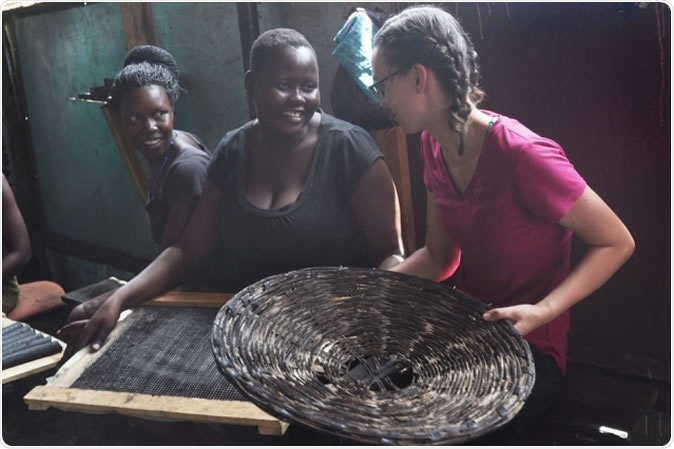According to the World Health Organization, around 3.8 million people die annually as a result of exposure to soot and smoke from wood burning cook stoves that millions still cook on, around the globe. The WHO says that these stoves carry a risk of not only lung diseases but also pneumonia, stroke, low birth weight and lung cancers. The most vulnerable populations exposed to this smoke remain the women and children.

Senior Danielle Gleason (right) speaks with Goretti Ariago (center) and Salume Awiyo (left), employees of Appropriate Energy Saving Technologies, in Soroti, Uganda. Gleason has made two trips to Uganda to help streamline the production of charcoal briquettes which offer a low-smoke alternative for home cooking fuel. Photo: John Freidah
Betty Ikalany, founder and chief executive director of Appropriate Energy Saving Technologies (AEST), and her team are working on improving the present conditions and providing healthier cooking options to women in Uganda. Ikalany said in a statement, “All their life they’re exposed to this smoke. Ten thousand women die annually in Uganda because of inhaling smoke from cook stoves.”
Ikalany has been collaborating with Amy Smith, founding director of MIT D-Lab since 2012. They have been developing briquettes that produce no soot on use and also reduce the amount of smoke produced drastically. The same year Ikalany set up AEST that helps produce and distribute the briquettes to the Ugandan women.
A Cleaner Burn
The team explains that the briquettes are an alternative to wood on the cook stoves. These briquettes are made up of carbonized agricultural waste including corn husks, peanut shells and also charcoal dust added to it. Overall binding agent is a cassava-water porridge explains the AEST team. They are wet when produced and need to be sun and air dried. The AEST team dries these on open-air racks. It takes around three days for the briquettes to dry. This may be difficult during wet seasons and humid weathers, say experts. Danielle Gleason, a senior studying mechanical engineering said, “The drying of the briquettes is the bottleneck of the whole process. In order to scale up production and keep growing as a business, Betty and her team realized that they needed to improve the drying process.”
Gleason and one of her colleagues, Daniel Sweeney, a research scientist at MIT D-Lab travelled to Uganda to help solve the problem of drying the briquettes and optimize the whole process. Maria Yang, professor of mechanical engineering and faculty academic director at MIT D-Lab, said in a statement, “Drawing upon their strong theoretical foundation and experiences in the lab and the classroom, we want our students to go out into the field and make real things that have a lasting impact.” Gleason was a sophomore at the college at the time. She explained, “I went to Uganda not to present an incredibly complex solution, but simply to learn from our community partners, to share some ideas our team has been working on, and to work directly with those who will be impacted by our designs.”
At the MIT D-Lab 2.652/EC.712 (Applications of Energy in Global Development), Gleason and a team of students started working on a simple drying system for the briquettes. She said, “We spent a whole semester figuring out how to improve this airflow and naturally convect the air.” They designed three different methods to dry the briquettes and were at the verge of testing them. Gleason said, “You can prototype and test all you want, but until you visit the field and experience the real-world conditions and work with the people who will be using your designs, you never fully understand the problem.”
Last year the team kept improvising their designs until they had covered dryers that could be used to dry the briquettes in the sun as well as during rains. Ikalany said, “We believe that once we are able to scale up what we have learned from Danielle and her team we should be able to produce five times more a day. Our production capacity will increase and the demand for customers will be met.”
The AEST website says that it is a woman led social enterprise and helps women not only use safer fuel alternatives for cooking but also creates a livelihood opportunity for them. It helps the population choose cleaner and sustainable fuel sources for cooking and hopes to cut down the dependence on wood fuel in Uganda. They explain that each year around 120,000 hectares of trees are cut down in Uganda to meet the wood fuel demands. AEST strives to make organic charcoal from the agricultural waste in not only rural areas but also urban and semi urban areas of Eastern Uganda. The team says that their overall goal is, “to contribute to improvement in health for people in low income households and institutions that rely on firewood and wood charcoal for cooking and heating in Uganda.”